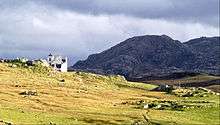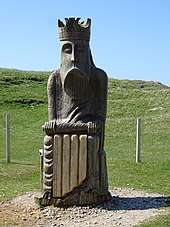Uig, Lewis
Uig (Scottish Gaelic: Ùig), also known as Sgìr' Ùig, is a civil parish and community in the west of the Isle of Lewis in the Outer Hebrides, Scotland. The Parish of Uig is one of the four civil parishes of the Isle of Lewis. It contains the districts of Carloway, East Uig, Bernera and West Uig (commonly known as Uig district or Uig Lewis). The name derives from the Norse word Vik meaning 'a bay'.
Uig
| |
|---|---|
 Uig Community Shop | |
 Uig Location within the Outer Hebrides | |
| Language | Scottish Gaelic English |
| OS grid reference | NB022334 |
| Civil parish |
|
| Council area |
|
| Lieutenancy area | |
| Country | Scotland |
| Sovereign state | United Kingdom |
| Post town | ISLE OF LEWIS |
| Postcode district | HS2 |
| Dialling code | 01851 |
| Police | Scotland |
| Fire | Scottish |
| Ambulance | Scottish |
| UK Parliament | |
| Scottish Parliament | |
Uig District
Geography
Uig (Lewis) otherwise known as West Uig is the largest and most sparsely populated district of the Isle of Lewis. It contains the highest point on the island, Mealasbhal (574 m or 1,883 ft) and also another six of the highest ten peaks. The deepest lake, Loch Suaineabhat at 67 metres (220 feet), is the deepest offshore lake in the British Isles. The coast has significant inlets notably Little Loch Roag, Langabhat, Loch Thamnabhagh, Loch Reasort and Uig Bay.
Uig Bay contains a vast strand of shell beach which produces a fertile "machair" fringe. Other shell sand beaches and machair are found at Tràigh na Beirgh, Bhaltos, Cliff, Capadale, Mangurstadh and Mealastadh.
The Atlantic west coast from Gallan Head to Loch Reasort is dominated by cliffs and many small chasms known as "geodhs". Inland the land contains a glaciated profile with thin acidic soil and large rock outcrops of Lewisian gneiss. Of geological note is the discovery of the largest sapphire ever found in the British Isles. The 242-carat (48.4-gram) stone discovered in 1995 is on display at the National Museum of Scotland.
History
Evidence of extensive Norse settlement have been uncovered most notably through interpretation of the placenames in the district but also through archaeological discoveries some of which are on display at the Uig Museum. The name Uig is generally accepted to be derived from the old Norse "Vík". Military service – Uig district was a fruitful recruiting ground for soldiers in the 78th Seaforth Highlanders for the Napoleonic Wars and were notably recruited in four waves in 1778, 1793, 1794 and 1804. Most notable in battle honours won was the victory at Maida, Italy 1806 and Java in 1811. Clearances – Despite military service and the ultimate sacrifice by many, the district was the subject of widespread evictions in the nineteenth century to make way for enlarged sheep farms and sporting estates. Villages around Uig Bay that were cleared were: Capadale, Pennydonald, Baileneacail, Baileghreusaich and Earastadh and the largest township in the district, Mealastadh was also cleared. Parallel with the Highland clearances arose the birth of organised crofting in the 1840s. This produced the individual land holdings and linear township pattern recognisable today. The crofting system has always proved inadequate to provide an income for the people so other forms of income have always been crucial for the survival of these communities. Notable were the kelp industry and the great line fishing industry. The main sporting estates that were set up were at Uig Lodge, Morsgail and Scaliscro.
Demographics and social history
The current population of the district is around 400, which is the lowest recorded. This is compounded by an ageing demographic and a "constrictive pyramid" structure. The district had recorded 1,923 residents in 1841, prior to evictions that occurred over the next decade. The most notable evictions resulted in the passage of hundreds of people on the emigrant ships "Marquis of Stafford" and "Barlow" in 1851. At the turn of the twentieth century there were 1,631 residents in the district, and the population dipped below 1,000 for the first time after the Second World War.
Notable people
- Dòmhnall Càm MacDhùghaill (c1560-c1640) – Born in the district. Clan chief of the MacAulays of Uig. Progenitor of the race of MacAulays including:
- Zachary MacAulay (1768-1838) – Anti slavery campaigner with the Clapham Sect. He was a notable Statistician and a founder of the University of London.
- Thomas Babington Macaulay (1800–59) – 1st Baron Macaulay and British Whig politician and historian. Author of "A History of England from the Accession of James II".
- Robertson MacAulay - President of the Sun Life Insurance Co of Canada then the largest insurer in the world and his son TB MacAulay also President of the Sun Life Insurance Co.
- Kenneth MacKenzie, Baile-na-Cille – Born in the district. Otherwise known as the Brahan Seer. He was a notable prophet of the 17th Century who predicted the arrival of oil revenues among other predictions.
- William J MacLean (1841-1929), Scaliscro/Gisla - Born in the district. Chief Trader for the district of Lower Fort Garry (Winnipeg) for the Hudsons Bay Company.
- Murdo F Macdonald (1849-1920), Geisiadar – Born and educated in the district. Founder of the Blue Mountain Granite Co of Vermont. Produced many civic statues for American cities and memorials for the American Civil war.
- Rev Colonel AJ MacKenzie (born 1887), Kinlochroag – Born and educated in the district. An army chaplain who wrote several memoirs of the traditions of the district.
- Capt. Alexander Maclennan (born 1892), Bhaltos - Officer with the 16th Canadians at Amiens in WW1 who was awarded the Military Cross and Bar.
- Donald MacDonald (1891-1961), Carisiadar – Born and educated in the district. Medal winner in Medicine at the University of Edinburgh and also a notable London surgeon. He is better known as a noted folklorist and in particular his book “Tales and Traditions of the Lews”.
- Brian Wilson (1948 -), Mangurstadh - Resident in the district. Former cabinet minister in the Blair and Brown UK administration.
- Joni Buchanan, Mangurstadh - Raised, educated and resident in the district. Author.
- Donald Morrison (1964-), Mangurstadh – Raised and educated in the district. Writer, Journalist and Broadcaster.
Gaelic
According to the 2011 Census, there are 873 Gaelic speakers (56%) in Uig Parish.
Geography
The civil parish of Uig extends over a considerable area (roughly 250 sq mi or 650 km2) from the Harris border in the south to Dalmore in the north, and from Brenish in the west to Lochganvich in the east. The district known locally in Lewis as Uig is also called "West Uig" and is broadly the area west of Little Loch Roag (the narrow inlet extending south from (West) Loch Roag). West Uig contains 20 settlements; Uig parish contains 36 settlements.

West Uig was a district of 2,000 people around the 1841 census, but the Highland Clearances had set in by then and this parish suffered greatly. The villages of Capadale, Pennydonald, Balnicol, Balgreasich and Erista, around where the modern scattered crofting township of Ardroil now stands, were some of the many cleared to make way for sheep farming and country sports.
Uig Beach (Scottish Gaelic: Camas Ùig) is surrounded by the villages of Cradhlasta (Crowlista), Tuimisgearraidh (Timsgarry), Eadar Dhà Fhadhail (Ardroil) and Càrnais (Carnish).
Bhaltos (Valtos) is the largest village in Uig and is home to about 35 people. Since 1999 the land on the Bhaltos peninsula, comprising also the smaller villages of Cliobh (Cliff), Cnìp (Kneep), Riof (Reef) and Na h-Ùigean (Uigen), has been owned by the community and managed by the Bhaltos Community Trust.[1]
Beach
Uig Beach (Scottish Gaelic: Camas Ùig) is best known as the site where the Lewis Chessmen (Scottish Gaelic: Tàileasg Ùig) were found. Before 1831, a local crofter discovered a buried hoard of chess pieces, uncovered by a storm. The chessmen are now in the Museum of Scotland, Edinburgh with an overseas exhibit in the British Museum in London, and replicas in the Uig Heritage Centre in Tuimisgearraidh. They are mostly carved from walrus tusks, and probably originated in Norway sometime in the 12th century, although when and how they came to be in Uig is unknown.[2]
The beach is one of Scotland's leading kite-buggy locations, being large, flat, and frequently subject to suitable winds.[3]
People
Uig is the ancestral seat of the Clan MacAulay (Mac Amhlaigh), who are of Norse descent (Olavsson). The most famous clan chief was Donald Cam MacAulay, and his descendants have included the anti-slavery campaigner Zachary Macaulay and his son Thomas Babington Macaulay, 1st Baron Macaulay who wrote A History of England. A later ancestor, T B MacAulay, founded the Sun Life of Canada insurance company. According to Lewis tradition, Uig is the birthplace of Coinneach Odhar, the Brahan Seer, a Nostradamus-type figure of the 16th century.[4]
Archaeology and Historical Sites

Calanais Stones
The principal historical site in the parish is the Calanais Stones which are a neolithic site of international importance. They are unusual in being cross-shaped with an avenue leading to the central point. This main Calanais site is connected to seven other stone circles in the locality.
Dùn Carloway
This is the second best preserved example of an Iron Age broch in Scotland after Mousa in Shetland. Other brochs in the parish include: Dùn Borrainis, Dùn Bharabhat (Cnìp), Dùn Bharabhat (Bernera) and Dùn Stiùgh.
Cnìp
A well-preserved wheelhouse at Kneep, and two nearby brochs, make the area important archaeologically. In 1979 a rich female Viking burial was discovered on Kneep headland.[5]
Lewis Chessmen
Pennydonald by Uig Bay was the place of discovery of the Lewis Chessmen in 1831. They are generally recognised as one of the most important Norse artefacts ever discovered.
Bòstadh
The remains of inter-connected circular houses are by the beach at Bòstadh, Bernera. They date from the Iron Age. A re-construction of this part sub-terranean habitation is located nearby. Intact remains of further pre-Norse houses with overlapping flagstone roofs known as "beehive dwellings" are to be found on the Morsgail Moor and at Aiscleit.
Pre-reformation chapels
The distinct remains of the following chapels exist in the parish: St.Kiarans, Laimisiadar, St Michaels, Kirivick, St Macrels, Kirkibost, St Dondans and St Michaels, Little Bernera, St Peters, Pabaigh Mhòr, St Christophers, Uig Bay, Tigh na Beanaich, Aird Uig, Tigh na Cailleachan Dhubha, Mealastadh.
Norse water mills
The remains of many mills which used horizontal carved millstones are throughout the parish. Only one, at Breaclet, Bernera is roofed but others of note are found at Croir, Geisiadar, Pennydonald, Carnish and virtually every other township in the parish.
Fishing industry
The remains of nineteenth century fish curing houses are to be found at Little Bernera, Croir, Tòb Bhalasaigh, Dunan Carloway, Bhaltos and Carnish. Other important sites are the Bernera lobster pond at Tòb Blàr Meadha and lobster ponds on the Isle of Pabaigh Mhòr.
Abhainn Dearg Distillery
The Abhainn Dearg Red River Distillery, which began distilling in 2008, is located at Carnish in Uig, and claims to be "the first legal distillery in the Outer Hebrides since 1829".[6][7]
References
- "Bhaltos Community Trust Ltd – Uigean". Firstport Business Directory. Archived from the original on 19 March 2012. Retrieved 4 February 2011.
- "The Lewis Chesssmen". The British Museum. Retrieved 27 February 2013.
- "Fly a white kite". VisitScotland. Retrieved 4 February 2011.
- "The Viking Princess and the Seeing Stone". www.ceuig.com. 9 August 2008. Archived from the original on 13 November 2010. Retrieved 11 February 2010.
- "A Viking burial from Kneep, Uig, Isle of Lewis" (PDF). Proc Soc Antiq Scot. 111 (1987): 149–174. Retrieved 30 January 2009.
- "About Abhainn Dearg Distillery" Archived 27 May 2014 at the Wayback Machine. abhainndearg.co.uk. Retrieved 23 August 2014.
- "Abhainn Dearg Scotch Whisky". whiskymerchants.co.uk. Retrieved 4 February 2011.
External links
| Wikimedia Commons has media related to Uig, Isle of Lewis. |